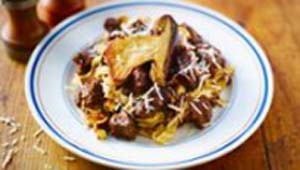 Wild boar ragù with fresh pasta
Wild boar ragù with fresh pasta
From: BBC Food & Drink
For the ragú
olive oil, for frying
1 onion, peeled and finely chopped
2 carrots, peeled and finely diced
2 sticks celery, finely diced
2 garlic cloves, peeled and finely sliced
flour, for dusting
salt and freshly ground black pepper
750g/1lb 10oz wild boar neck or shoulder, chopped into 3cm/1in cubes
100g/3½oz pancetta
1 bay leaf
5cm/2in strip of orange rind
375ml/13fl oz red wine, preferably Italian
2 tbsp tomato purée
4 sprigs oregano, leaves picked and roughly chopped
For the pasta
300g/10oz tipo 00 flour
½ tsp salt
3 free-range eggs
semolina, for dusting
 To serve
To serve
250g/9oz fresh porcini mushrooms, halved lengthways
olive oil, for frying
fresh parmesan, to serve
1. Preheat the oven to 150C/300F/Gas 2.
2. Heat the oil in an ovenproof, heavy-based pan or casserole set over a low-medium heat. Add the onion, carrot, celery, garlic and bay leaf.
3. Season the flour with salt and pepper. Lightly coat the wild boar in the seasoned flour. Add some olive oil to a separate pan set over a high heat and add the wild boar pieces. Fry until the meat is golden-brown on all over - this may have to be done in batches to avoid crowding the pan.
4. When the vegetables have softened, add the pancetta, bay leaf and orange rind to the pan. Cook for about five minutes until much of the pancetta fat has rendered and the vegetables have browned a little
around the edges.
5. Add the browned boar meat to the vegetables. Pour the red wine into the frying pan used to brown the meat. Cook over a medium heat, scraping the bottom of the pan to loosen any charred bits of meat.
6. Add the tomato purée to the ragú and stir it through. Cook for two minutes stirring regularly to avoid burning.
7. Pour the warm wine into the ragú, add 200ml/7fl oz water and bring to a simmer. Add the oregano leaves and stir through.
8. Put the lid on the pan and place in the preheated oven for 1½ hours, or until the meat is meltingly tender and the liquid reduced. Check once or twice in this time and stir to prevent the meat on the surface drying out.
9. In the meantime make the pasta.
Tip out the flour on to a clean surface and create a small well in the middle. Sprinkle over the salt.
10. Crack the eggs into the well and, using a fork, begin whisking the eggs, slowly working in the flour. Once most of the flour has been incorporated, use your hands to knead the dough for about five minutes. The dough should be smooth and pliable. If not keep kneading until it is.
11. Wrap the pasta in cling film and set aside to rest for 5-10 minutes.
12. Halve the dough and pass one half through each stage of a pasta machine twice, starting at the widest setting and working down until you have passed it through the thinnest setting. Coat the pasta with a little semolina flour to stop it sticking and set aside for a few minutes to dry slightly. Repeat with the remaining pasta.
13. Cut the pasta sheets using the tagliatelle cutter or, if cutting by hand, take one of the short ends of the pasta and fold over a 5cm/2in strip. Keep folding until you have a parcel of pasta, then slice the parcel into 1cm/½in wide strips – cutting from the short end to produce long strips of pasta. Coat the strips in a little more semolina flour to prevent them sticking together.
14. When ready to cook, bring a large pot of water to the boil and add a generous amount of salt. Drop your pasta in and cook for about three minutes before draining. Dress with a little olive oil if not eating immediately.
15. Before serving, add a little olive oil to a pan over a medium-high heat. Once smoking, add the halved mushrooms and sauté for 2-3 minutes.
16. To serve, tip the pasta into the finished ragù and serve in portions topped with freshly grated parmesan and fried mushrooms.

